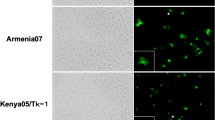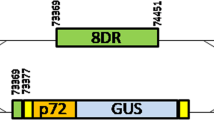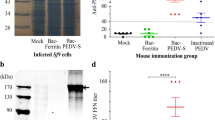Abstract
FOLLOWING prolonged adaptation to cell cultures, several isolates of African swine fever virus (ASFV) produce cytopathic effects in pig kidney (PK) cells1–3. We have found that at least two such strains, Uganda3 and Hinde1, consistently produce plaques in monolayers of PK cells under solid overlays; this observation has led to the development of a quantitative technique using any of three PK cell strains (PK/A, PK/C and PK/13) developed by us during a period of 3 years.
This is a preview of subscription content, access via your institution
Access options
Subscribe to this journal
Receive 51 print issues and online access
$199.00 per year
only $3.90 per issue
Buy this article
- Purchase on Springer Link
- Instant access to full article PDF
Prices may be subject to local taxes which are calculated during checkout
Similar content being viewed by others
References
Malmquist, W. A., Amer. J. Vet. Res., 23, 241 (1962).
Sanchez Botija, C., Bull. Off. Int. Epiz., 60, 901 (1963).
Hess, W. R., Cox, B. F., Heuschele, W. P., and Stone, S. S., Amer. J. Vet. Res., 26, 141 (1965).
Cooper, P. D., Adv. Virus Res., 8, 319 (1961).
De Boer, C. J., Arch. Ges. Virusforsch., 20, 165 (1967).
Cox, B. F., and Hess, W. R., Bull. Epiz. Dis. Afr., 10, 439 (1962).
Author information
Authors and Affiliations
Rights and permissions
About this article
Cite this article
PARKER, J., PLOWRIGHT, W. Plaque Formation by African Swine Fever Virus. Nature 219, 524–525 (1968). https://doi.org/10.1038/219524a0
Issue Date:
DOI: https://doi.org/10.1038/219524a0
This article is cited by
-
A microtechnique for the titration for african swine fever virus
Archives of Virology (1980)
-
Plaque formation by African swine fever virus in chick embryo fibroblasts in the absence of CO2 atmosphere
Archives of Virology (1976)
-
Studies to determine the presence of neutralizing antibody in sera and kidneys from swine recovered from African swine fever
Archiv f�r die gesamte Virusforschung (1969)
Comments
By submitting a comment you agree to abide by our Terms and Community Guidelines. If you find something abusive or that does not comply with our terms or guidelines please flag it as inappropriate.



